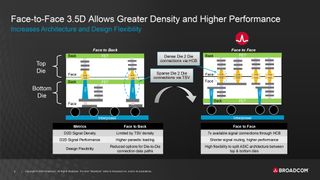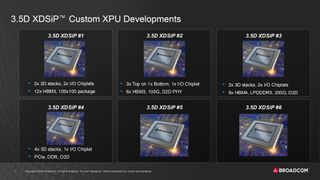Broadcom Unveils Cutting-Edge 3.5D XDSiP Platform for AI and HPC Processes
Broadcom has recently made waves in the tech world by introducing its innovative 3.5D eXtreme Dimension System in Package (3.5D XDSiP) platform, tailored for ultra-high-performance processors that cater to the intense demands of AI (Artificial Intelligence) and HPC (High-Performance Computing) workloads. This state-of-the-art platform leans heavily on TSMC’s advanced packaging technologies, particularly the CoWoS (Chip on Wafer on Substrate) system, enabling chip designers to forge system-in-packages (SiPs) featuring 3D-stacked logic, networking, I/O chiplets, and HBM (High Bandwidth Memory) stacks.
Unmatched Performance Capabilities
The 3.5D XDSiP platform is a game changer, allowing SiPs to reach astonishing sizes of up to 6000mm² of stacked silicon, accommodating up to 12 HBM modules. With the first product offerings projected to hit the market by 2026, this technology promises to redefine processing capabilities.
Advanced Technology Integration
At the heart of Broadcom’s 3.5D XDSiP is TSMC’s CoWoS-L packaging technology, which flaunts a maximum interposer size that is about 5.5 times larger than a typical reticle—supporting compute chiplets, I/O chiplets, and multiple HBM packages. To enhance performance even further, Broadcom suggests an innovative design methodology that stacks logic chiplets in a face-to-face (F2F) configuration. This hybrid copper bonding (HCB) method not only maximizes signal connections—up to seven times more than traditional methods—but also significantly reduces power consumption and minimizes latency.
According to Broadcom, this advanced stacking technique is a notable upgrade over the face-to-back (F2B) approach, which relies on through-silicon vias (TSVs). The benefits of the F2F method encompass faster signal routing and increased flexibility in semiconductor architecture, thereby enabling design teams to optimize performance while reducing energy waste.
(Image credit: Broadcom)
Insights from Industry Leaders
Frank Ostojic, Senior Vice President and General Manager of the ASIC Products Division at Broadcom, remarked, "In close collaboration with our customers, we have created a 3.5D XDSiP platform by leveraging advanced technologies from TSMC and EDA partners. By stacking chip components vertically, we enable designers to implement the most suitable fabrication processes for each component while effectively shrinking the interposer size."
Echoing this sentiment, Dr. Kevin Zhang, Senior Vice President from TSMC, noted the fruitful partnership between the two companies, emphasizing their collective aim to enhance processing through advanced logic and 3D chip stacking technologies.
Targeting Future Needs in AI and HPC
Broadcom’s 3.5D XDSiP platform is set to bolster processing capabilities for major companies like Google, Meta, and OpenAI, which have an insatiable need for performance in AI and HPC applications. This platform will also offer a comprehensive suite of intellectual properties (IPs), including HBM PHY, PCIe, and GbE, plus a range of full-solution chiplets and silicon photonics. This will allow clients to focus on refining processor architecture instead of getting lost in the complexities of manufacturing.
Currently, the flagship product under the 3.5D XDSiP platform combines four compute dies, one I/O die, and six HBM modules—all designed with TSMC’s leading-edge processes.

(Image credit: Broadcom)
Furthermore, Broadcom is actively developing five additional products built on this technology, which includes not just initiatives for the expanding AI landscape but also the Fujitsu Monaka processor, a robust application envisioned for both AI and HPC, leveraging Arm architecture and TSMC’s upcoming 2nm-class process technology. Expected shipments of the 3.5D XDSiP products are slated to begin in February 2026.

(Image credit: Broadcom)
Naoki Shinjo, Senior Vice President at Fujitsu, remarked on the longstanding partnership with Broadcom, highlighting how this latest platform will empower Fujitsu’s next-gen 2nm Arm-based processors to achieve high performance with lower power consumption and cost.
Conclusion
With technological advancements like Broadcom’s 3.5D XDSiP platform, the future of computing for AI and HPC looks exceptionally promising. The collaboration between these industry giants is bound to yield breakthroughs that could redefine high-performance applications.
The AI Buzz Hub team is excited to see where these breakthroughs take us. Want to stay in the loop on all things AI? Subscribe to our newsletter or share this article with your fellow enthusiasts.




